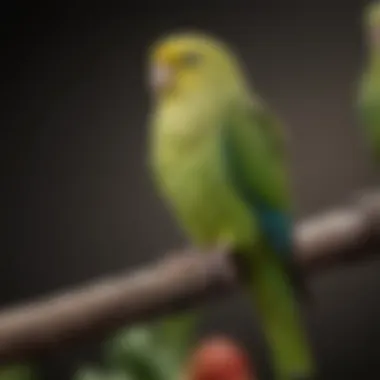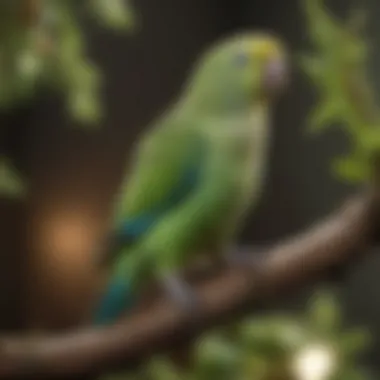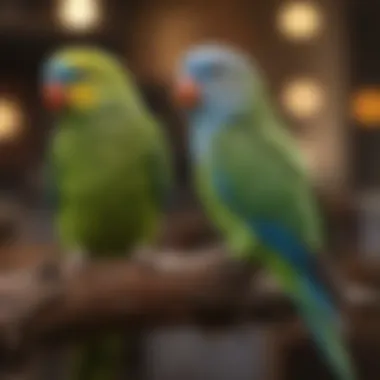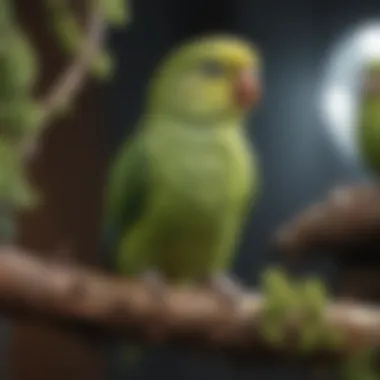Natural Parakeet Perches: Enhance Your Bird's Life


Intro
Natural parakeet perches play a significant role in the well-being of pet parakeets. As these birds naturally occupy diverse environments, selecting appropriate perches ensures they can exhibit their instinctual behaviors and maintain their physical health. The correct perch not only contributes to comfort but also encourages activity and social interaction, which are essential for mental stimulation. This guide covers the different types of natural perches available, their advantages for your bird's health, and the essential criteria for making an informed choice. Furthermore, maintenance practices to ensure longevity and safety of these perches will also be examined.
Understanding Your Pet
Pet Behavior Basics
Parakeets are social creatures. They require more than just food and water to thrive. A natural perch mimics their natural habitat, allowing them to engage in climbing and perching behavior. Such activities contribute to their physical strength and mental health.
Common Breed Characteristics
Different parakeet breeds exhibit unique behaviors and preferences. For example, budgerigars may prefer narrow perches for resting, while larger parakeets like the African Grey might require thicker and sturdier options. Understanding these characteristics helps in selecting suitable perches.
Species-Specific Needs
Every species has specific needs. For example, species such as the Alexandrine Parakeet require larger space due to their size. Hence, it's crucial to know the specific needs of your pet parakeet, which can influence perch selection, size, and type.
The Benefits of Natural Perches
Natural perches offer several benefits:
- Health Improvement: They help in maintaining the birds' claws and beaks naturally, decreasing the risk of overgrown nails.
- Mental Stimulation: Varied textures and sizes provide stimulation, encouraging exploratory behavior.
- Comfort: Natural materials often provide a more comfortable resting place compared to synthetic alternatives.
Natural perches can significantly enhance the quality of life for parakeets, considering their health and behavioral needs.
Selecting the Right Perch
Material Considerations
The material of the perch matters. Wood is often the best choice. It is safe and allows for natural chewing behaviors. Many bird owners opt for branches from non-toxic trees like manzanita, pine, or apple.
Size and Thickness
The size of the perch should fit the bird's size perfectly. If it's too small, the birds are uncomfortable. Conversely, a perch that is too large may be challenging to grasp. For small parakeets, a perch with a diameter of around 1/2 inch works well.
Installation
Proper installation is key. Ensure perches are stable and positioned in a way that your parakeet can easily access them. It's often beneficial to avoid placing them directly above food or water bowls to keep them clean.
Maintenance Practices
Maintaining natural perches requires some effort, but it is crucial for the health of your parakeet:
- Regular Cleaning: Wash perches regularly with mild soap and water to prevent bacteria buildup.
- Inspection: Regularly check for wear and tear, replacing them as needed to avoid splinters.
- Placement Rotation: Occasionally change the placement of your perches to keep the environment engaging.
Finale
Natural parakeet perches are more than merely accessories in a cage. They are essential components that significantly affect the health and happiness of your pet. By understanding your parakeet's needs, selecting the right materials and sizes, and maintaining them properly, you can provide a safe and stimulating environment that enhances your pet's quality of life.
Foreword to Natural Parakeet Perches
Understanding the ideal living environments for our pets is essential for maintaining their well-being. Parakeets, known for their lively and social nature, greatly benefit from natural perches. Unlike synthetic options, natural perches offer a more authentic experience that is closer to their wild habitat. They promote not just physical health but also mental stimulation.
When choosing a perch for your parakeet, several elements must be taken into consideration. Material is crucial; natural wood types, for instance, are often preferred as they mimic trees found in their natural surroundings. Different sizes and shapes enhance the overall habitat, allowing for exploration.
Moreover, the health benefits of natural perches cannot be understated. Parakeets engage more actively when they interact with natural textures. This active behavior supports their physical condition, helping to maintain healthy claws and contribute to muscle strengthening.
Natural perches allow parakeets to express their instinctual behaviors, leading to a more fulfilled life.
Understanding Parakeet Behavior
Understanding parakeet behavior is essential for enhancing the life quality of these avian companions. This segment provides insights into their natural habitats and instinctual tendencies. Knowledge of their behavioral patterns assists in creating a suitable environment for them, which is crucial for their health and well-being. As pet owners, recognizing the elements that influence a parakeet's happiness will lead to better care choices.
Natural Habitat and Perching Habits
In the wild, parakeets inhabit open grasslands and forests across Australia. Their natural setting involves a high degree of social interaction and constant movement among trees and shrubs. Parakeets prefer perching on branches to observe their surroundings and communicate with their flock. This behavior promotes safety from predators and fosters social bonding.
When choosing perches, consider replicating their natural environment. Natural wood perches offer varying diameters and textures, mimicking the branches they would typically perch on. The importance of diverse perch types cannot be overstated; they allow for both comfort and exercise, critical aspects of a parakeet's routine.
Importance of Perches for Physical Health
Perches play a crucial role in a parakeet's physical health. They help in maintaining foot strength and can prevent diseases related to inactivity. When a parakeet climbs, it engages different muscle groups, supporting its fitness.


It is essential to have multiple perches at different heights. This variation encourages movement, essential for proper exercise. Moreover, perches made from natural materials can aid claw health by providing rough surfaces that promote the natural wearing of nails.
Social Interaction and Perching
Parakeets are naturally social creatures. They thrive on interaction with others, both human and avian. Their perching habits reflect this social nature. When parakeets perch together, they communicate through vocalizations and physical proximity, strengthening their bonds.
In a home environment, it is vital to create a setting where social interaction can take place. Ensure that perches are placed at varying heights and allow for easy access and visibility among birds. This setup fosters healthy interactions, which are crucial for their mental and emotional health.
Understanding parakeet behavior aids in enhancing their living conditions. This knowledge directly impacts their overall happiness and quality of life.
Benefits of Natural Perches
Natural perches play a crucial role in the well-being of parakeets. They provide more than just a place to sit; they contribute to the overall physical and mental health of these birds. When selecting natural perches, understanding their benefits is essential for making informed decisions that will promote a happy and healthy environment for pet parakeets.
Promoting Natural Claw Wear
One significant advantage of natural perches is their ability to promote natural claw wear. Unlike synthetic perches, which can have smooth surfaces, natural wood typically exhibits variations in texture. These variations allow parakeets to engage their claws effectively, preventing overgrowth and other related issues.
A responsible pet owner should check the claws of their birds regularly. Enabling proper claw wear can help maintain healthy feet and prevent problems such as arthritis or infections. It is advisable to include natural perches made of different wood types, as each type may offer unique benefits for claw maintenance.
Encouraging Physical Activity
Natural perches encourage physical activity in parakeets. Birds are naturally active creatures, and providing a variety of perches encourages them to climb, hop, and explore their environment. This activity is essential for their physical fitness as well as their mental health.
By installing different types of perches at varying heights, owners can create a dynamic space for their parakeets. It encourages exercise and helps prevent obesity, a common issue among captive birds. Observing a parakeet actively moving and engaging with its environment is a reminder of their vibrant nature.
Providing Mental Stimulation
Mental stimulation is equally important for the health of parakeets. Natural perches can provide this stimulation simply through their structure and layout. Birds are curious and intelligent. They enjoy exploring their surroundings, and varied perching options add a layer of complexity to their habitat.
Natural features like branches with rough textures or unusual shapes can invite exploration. This engagement keeps a parakeet mentally sharp and reduces the risk of boredom, which can lead to undesirable behaviors. Incorporating perches that appeal to their natural instincts enhances their quality of life.
Providing a stimulating environment is essential for the well-being of parakeets. Using natural perches can significantly affect their health and happiness.
Types of Natural Parakeet Perches
Natural parakeet perches play a vital role in the well-being of these birds. Their selection affects comfort, health, and even psychological aspects of parakeet life. Choosing the right type of perch is not merely a matter of aesthetics. It contributes to the overall quality of life. Different materials serve various functions and have unique benefits.
Wooden Perches
Common Wood Types
Wooden perches are among the most popular choices for parakeet cages. Common types such as pine, birch, and manzanita provide natural texture and comfort for your birds. Pine is lightweight and readily available. However, one must ensure it is untreated and free from any harmful chemicals. Birch is durable and offers a smooth surface, while manzanita is often considered the premier choice due to its sturdiness and natural curve, helping parakeets to grip better.
Advantages
- Comfort: Wooden perches provide a softer surface than metal, helping to prevent foot injuries.
- Natural Feel: Wood mimics the natural environment and feels more comfortable for birds.
Disadvantages
- Wear and Tear: Wooden perches may wear down and require replacement.
- Cleaning: They can be harder to sanitize due to porous surfaces.
Pros and Cons
Understanding the pros and cons of wooden perches is essential. They often offer a great grip for your parakeet while providing comfort. However, they can harbor bacteria or pests if not maintained. Consider their longevity, as wood may rot or splinter over time.
Pros
- Natural Grip: Encourages healthy claw development.
- Variety: Comes in different sizes and shapes contributing to an interesting habitat.
Cons
- Maintenance: Requires regular checking for damage.
- Food Safe: Not all woods are safe. Some might introduce toxins to the environment.
Branch Perches
Natural vs.
Artificial Branches
Branch perches can also be very beneficial. Natural branches bring a touch of the wild into the cage. They provide different diameters, which is great for foot exercise. On the other hand, artificial branches might be easier to clean but often lack the natural grip. Both types have their unique advantages.
Benefits of Natural Branches


- Varied Textures: Each natural branch has unique character, useful for foot maintenance.
- Environmental Enrichment: Mimics the natural setting, promoting natural behaviors.
Drawbacks of Artificial Branches
- Limited Texture: May not offer the same gripping quality.
- Lack of Variety: Silly often similar and can lead to boredom among birds.
Selection Criteria
When selecting branch perches, consider a few factors. Diameter is crucial; it should match your parakeet's size. Also, look for branches that have not been chemically treated. Durability is another key aspect; the perch must withstand daily use without breaking.
Important Factors
- Diameter: Ideal range for parakeets is typically between ½ inch to 1 inch.
- Natural Materials: Make sure they come from non-toxic, untreated sources.
Rope Perches
Material Considerations
Rope perches are another alternative that can enhance a parakeet’s living space. The material used is usually cotton or sisal. This type of perch offers flexibility and, thus, encourages climbing and exploration. The texture can help exercise foot muscles but should be checked for fraying. Regular checks are necessary to prevent entanglement or ingestion of loose fibers.
Key Criterias
- Non-Toxic Material: Always select household-safe materials.
- Flexibility: Their ability to adjust to your bird’s needs is a major plus.
Safety Tips
Safety should always be a priority. Avoid any rope perch that begins to fray or shed, as this can create hazards. Replace them at the first signs of wear. Also, avoid perches with sharp edges or pointed ends that could injure your birds.
Regularly inspect all types of perches for signs of damage or deterioration. Proper maintenance extends their life and ensures your parakeet’s safety.
Safety Considerations
- Proper Sizing: The rope’s diameter should not be too thick for your bird’s grip.
- Secure Installation: Ensure ropes are securely attached to avoid accidents when in use.
Selecting the Right Perch for Your Parakeet
Selecting the right perch is critical for ensuring your parakeet's comfort, health, and overall well-being. Parakeets are naturally inclined to perch, and the right setup can facilitate their instinctual behaviors. An unsuitable perch may lead to discomfort or even health issues over time. This section covers size considerations and material quality to aid you in choosing the best perch for your feathered friend.
Size Considerations
Diameter Recommendations
The diameter of the perch is one of the most important factors to consider. A perch that is too thin can lead to foot problems, while one that is too thick may strain their toes. Ideally, perches should be about 1 to 1.5 inches in diameter. This size supports the natural grip of parakeets. Using a perch that allows for proper foot closure ensures comfort and promotes healthy claw function.
Advantages of diameter choice:
- Appropriate size encourages natural toe splay.
- Reduces risk of foot-related issues, such as arthritis.
- Provides stability when used for climbing.
Length Guidelines
Length is also important when selecting a perch. A perch that is too short limits movement and can discourage physical activity. A longer perch offers more room for exercise and is beneficial for parakeets who love to stretch their wings. Aim for a perch that spans across at least two-thirds of the cage width. This setup allows your parakeet to easily move and find a comfortable spot.
Key aspects of length:
- Encourages exercise, which is vital for parakeet health.
- Provides options for varying perching positions.
- Improves cage aesthetics by utilizing available space.
Material Quality
Toxic vs.
Safe Materials
Choosing materials that are safe for your parakeet is urgent. Common wood types like manzanita, birch, and pine are usually safe. However, some woods, like cedar, contain oils that can be harmful. It is important to verify that the perch material is free from pesticides, varnishes, or chemicals that can affect your bird’s health. Safe materials promote a healthier living environment and decrease the risk of toxicity.
Benefits of selecting safe materials:
- Reduces risk of health issues arising from toxic exposure.
- Supports a nurturing habitat that allows for natural behaviors.
- Enhances your confidence in the well-being of your pet.
Durability Factors
Durability is another vital element to consider. Natural perches made from hardwoods typically have a longer lifespan than softer woods. Investing in durable materials means less frequent replacements, reducing material waste and effort on the owner's part. Assessing the wear and tear on a perch every few weeks will help in determining when it needs replacement, ensuring a consistent quality environment.
Benefits of durable materials:


- Longer-lasting options save money over time.
- Reduces hassle from consistent replacements.
- Ensures your parakeet always has a safe, sturdy perch.
Ensuring that you consider both size and material quality not only enhances your parakeet's comfort but plays a crucial role in their health and happiness. Choosing perches wisely can fundamentally contribute to a better living environment for your pet.
Installation Best Practices
The installation of natural parakeet perches is essential not only for aesthetics but also for the comfort and wellbeing of your pet. Proper positioning and stability can significantly impact your parakeet’s experience and overall health. Understanding some best practices in this area can help optimize your parakeet's habitat.
Correct Placement within the Cage
The placement of perches within the cage affects how your parakeet interacts with its environment. There are key considerations to keep in mind when determining where to install the perches:
- Height Variation: Perches should be placed at different heights. This mimic their natural habitat, as parakeets typically perch higher to feel safe from predators.
- Avoiding Contamination: Ensure that perches are not positioned directly above food or water dishes. Droppings from higher perches can contaminate food and water, posing health risks.
- Accessibility: Place perches where they are easily accessible to your parakeet. They should not require excessive effort to reach, as this can lead to unnecessary stress.
By adhering to these principles, you create a climber-friendly environment that encourages natural behavior.
Maintaining Stability
Stability is paramount in ensuring the safety of your pet while perched. A wobbly or unstable perch can lead to accidents and potential injuries. Here are some factors to consider for maintaining stability:
- Secure Mounting: Make sure that the perch is securely attached to the cage. Use appropriate clamps or fasteners that are compatible with your cage design to prevent accidents.
- Regular Inspections: Periodically inspect the stability of each perch. Look for signs of wear, looseness, or damage. Address any issues immediately to keep your parakeet safe.
- Weight Distribution: Be mindful of both the size and weight of your parakeet. Choose an appropriate perch size that can support the weight, ensuring it remains steady during use.
Regular maintenance and correct installation can prolong the life of perches, safeguarding your parakeet against potential hazards.
By focusing on these aspects, you can create a safer and more stimulating environment for your parakeet, fostering not just comfort, but their overall wellbeing.
Maintenance of Natural Perches
Maintaining natural perches is vital for ensuring the health and well-being of your parakeet. Regular attention to these perches helps to maintain a clean environment and prolongs their usability. Parakeets, like all pets, flourish in a hygienic habitat, and perches are a central piece of their living space. Failing to maintain them can lead to health problems for your birds.
Cleaning and Hygiene
Cleaning Frequency
Cleaning frequency refers to how often the natural perches need to be cleaned. This is important for several reasons. First, regular cleaning removes droppings, food remnants, and other unsanitary materials. These can harbor bacteria and cause infections in your parakeet. Depending on your bird's activity level and the overall cage environment, you might need to clean the perches weekly or even more often.
A key characteristic of cleaning frequency is that it is governed by the level of mess created by your birds. For instance, more active or multiple parakeets can require more diligent cleaning. This frequent touch ensures a healthy habitat, and therefore, it is a beneficial choice for pet owners.
However, the unique feature of cleaning frequency is its adaptability; it can be adjusted based on the observation of the cage's condition. On the downside, some owners may overlook this responsibility and only clean them occasionally, which can lead to hygiene issues.
Safe Cleaning Materials
Using safe cleaning materials is essential for the overall health of your bird. Harmful chemicals can be toxic to parakeets, hence the need for careful selection. Ideal cleaning products include vinegar, water solutions, or pet-safe cleaners. The key characteristic of safe cleaning materials is their non-toxic nature, making them safer options for cleaning perches without risking the health of your birds.
This aspect is particularly beneficial as it allows pet owners to maintain hygiene without exposing their pets to harmful substances. The unique feature of using safe cleaning materials is their efficacy in removing grime while being gentle on surfaces. However, such materials might not always be as powerful as stronger chemical cleaners, requiring more effort in some cases.
Monitoring Wear and Tear
Monitoring wear and tear on natural perches is equally important. Over time, perches can become rough or significantly worn down. This can affect the grip strength of your parakeet's feet and could lead to injuries. Regularly checking for signs of damage not only protects your pet but also ensures that the perches remain safe and functional.
Keeping an eye on the condition of your natural perches allows you to replace them when necessary, thus providing continual support for your bird's health. It serves as a proactive measure that can prevent accidents and maintain a pleasant environment in the cage.
Common Issues with Natural Perches
Natural perches can enhance the well-being of parakeets, but they may also come with certain challenges. Understanding these common issues is crucial for pet owners who want to maintain a safe and healthy environment for their birds. Addressing these concerns effectively ensures that parakeets can enjoy the benefits of natural perches without unnecessary risk.
Pest Infestation
Pest infestation is a significant problem that can arise with natural perches. Since these perches are made from organic materials, they can attract insects like mites or woodlice. Here are some important points to consider:
- Source of Pests: Natural materials might harbor pests previously unseen. It is vital to obtain perches from reputable suppliers who treat their wood for pests.
- Signs of Infestation: Look for small droppings, webbing, or visible insects on or around the perch. These can indicate a pest problem that requires immediate attention.
- Prevention Methods: Regularly inspect the perches and clean them properly. You can use a mixture of vinegar and water for cleaning places where pests might hide.
Bacterial Growth
Bacterial growth is another concern linked to natural perches. The porous nature of many natural materials can create an environment conducive to bacterial development, especially when not properly maintained. Pet owners should pay attention to these aspects:
- Cleaning Routine: Establishing a regular cleaning routine is essential. Aim to wash the perches with safe and non-toxic solutions every couple of weeks to minimize bacterial proliferation.
- Signs of Bacterial Issues: If you notice an unusual odor, discoloration, or slimy texture on the perch, it may indicate bacterial growth. Affected perches should be cleaned or replaced promptly.
- Material Selection: Some woods are less prone to bacterial growth. Choosing materials like cedar may help mitigate this issue due to their natural antibacterial properties.
The End
In this article, the importance of natural parakeet perches is highlighted not only from the standpoint of aesthetics but more critically, from a health and well-being perspective for pet parakeets. Natural perches provide essential physical, social, and mental benefits that ensure a fulfilling environment for these intelligent creatures.
Physical health is a paramount consideration. Natural perches promote healthy claw wear and encourage physical activity, both crucial for maintaining robust feathers and muscles. When birds can climb and perch on varied surfaces, they develop strength and agility, important traits for their overall fitness.
Social interaction is another factor worth emphasizing. Parakeets are social creatures who thrive on interaction. The right perches can enhance their ability to interact with their environment and with their owners, fostering not just a symbiotic relationship but also giving them a sense of belonging.
Mental stimulation is significant in preventing boredom. Birds that are kept in environments rich in activity tend to exhibit fewer behavioral issues, enhancing their quality of life. When selecting perches, various factors need to be considered including size, material, and placement to align with the specific needs of the bird.
"The right perch is a basis for a healthy lifestyle for your parakeet."
Moreover, proper maintenance cannot be overlooked. Regular cleaning and monitoring for wear and tear ensure that the perch remains a safe environment for your pet. This diligence supports the longevity and durability of the perches, while also mitigating risks associated with pest infestations and bacterial growth.







